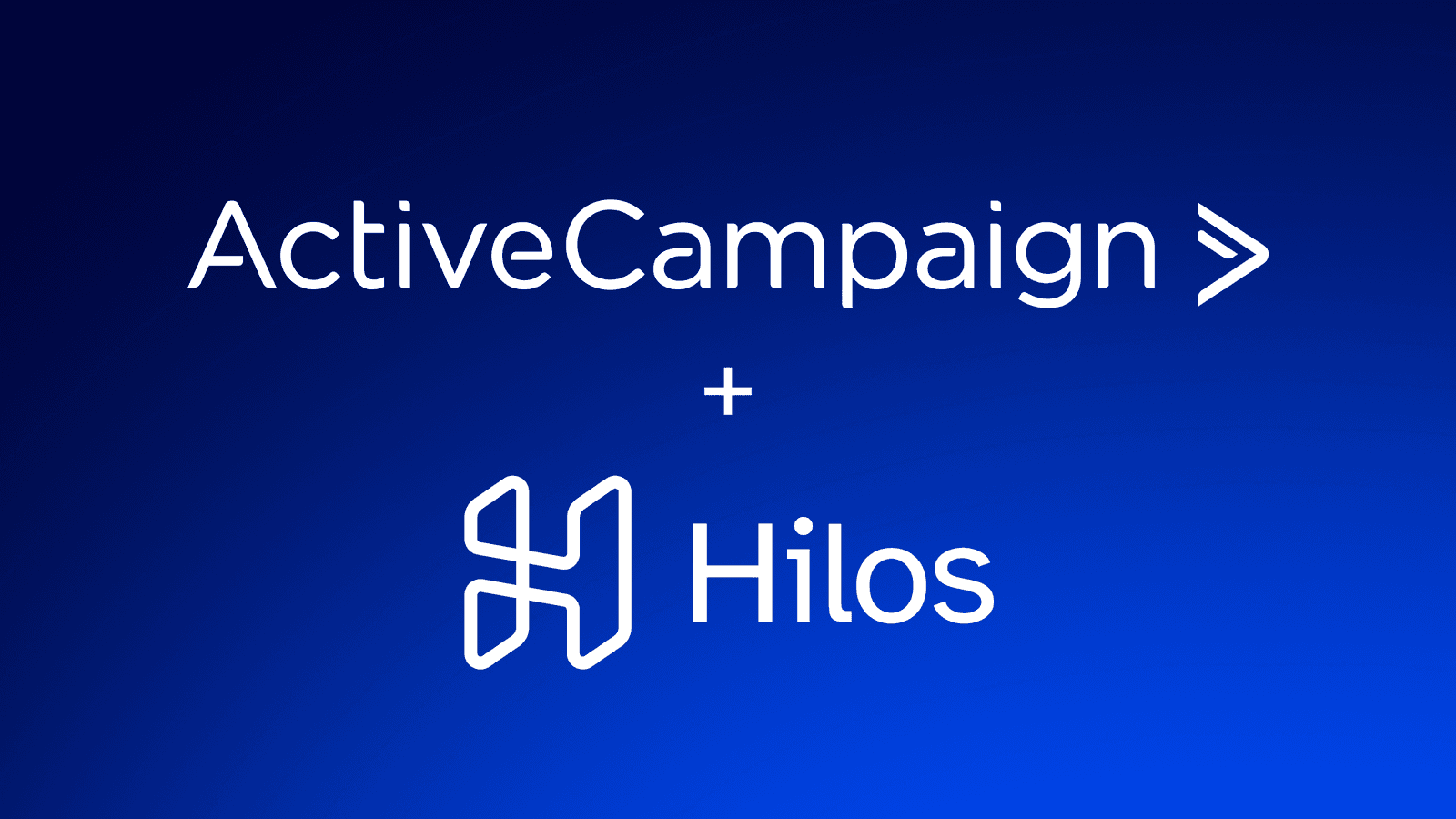This post was last updated on December 1st, 2023.
In December of 2017, the ActiveCampaign blog pulled in 8,765 visitors from organic search.
In June 2019, the ActiveCampaign blog pulled in 39,723 visitors from organic search.
In November 2021, the ActiveCampaign blog pulled in 119,037 visitors from organic search.
And, in September 2023, the ActiveCampaign blog pulled in 212,375 visitors from organic search.

How did we increase blog traffic so quickly? Consistent growth from 1 month to the next. These are the month-over-month (MoM) growth rates from the last 6 months:
- June to July: 25.09% MoM
- July to August: 19.66% MoM
- August to September: 27.67% MoM
- September to October: 20.49% MoM
- October to November: 30.15% MoM
And even though ActiveCampaign has a few advantages (like high domain authority), our approach can work for anyone—with any size website.
This post will show you how we did it, citing 10+ studies, 11 content marketing experts, and 6 Google patents (don’t worry, you don’t have to read them).
We’ll begin with 4 actionable strategies for promoting your blog and growing your blog audience. These tactics will help you reach people in and around your network and cultivate a pool of consistent readers and email subscribers.
After those blog growth tips, we’ll cover the 2 most important pieces of advice we can give:
- Write in-depth content that solves the reader’s problem
- Focus on search engine traffic by making search engine optimization (SEO) part of your writing process
Along the way, you’ll learn why you should write long blog posts (and how to do it well), why search engines are your most significant traffic opportunity, and how to combine killer content and smart SEO to grow your blog.
Table of contents
Top 4 ways to grow your blog audience
For a small publication or new blog, you can take some concrete steps to begin acquiring readers and developing a loyal audience. This is a great place to start if you’re wondering how to promote your blog for free or grow a blog from scratch.
1. Promote your blog on social media (strategically)
This does not just mean “share your blogs on Twitter.” Effectively promoting your blog on social media means finding the specific platforms, conversations, and content that get people to engage with your posts.
That begins with asking which social platforms your audience is on and what specific opportunities they present. For example, simply posting a link to your blog on your company’s Facebook page might not get noticed, but sharing content in a relevant Facebook group can get your work in front of brand new readers who are already looking for the type of content you create.
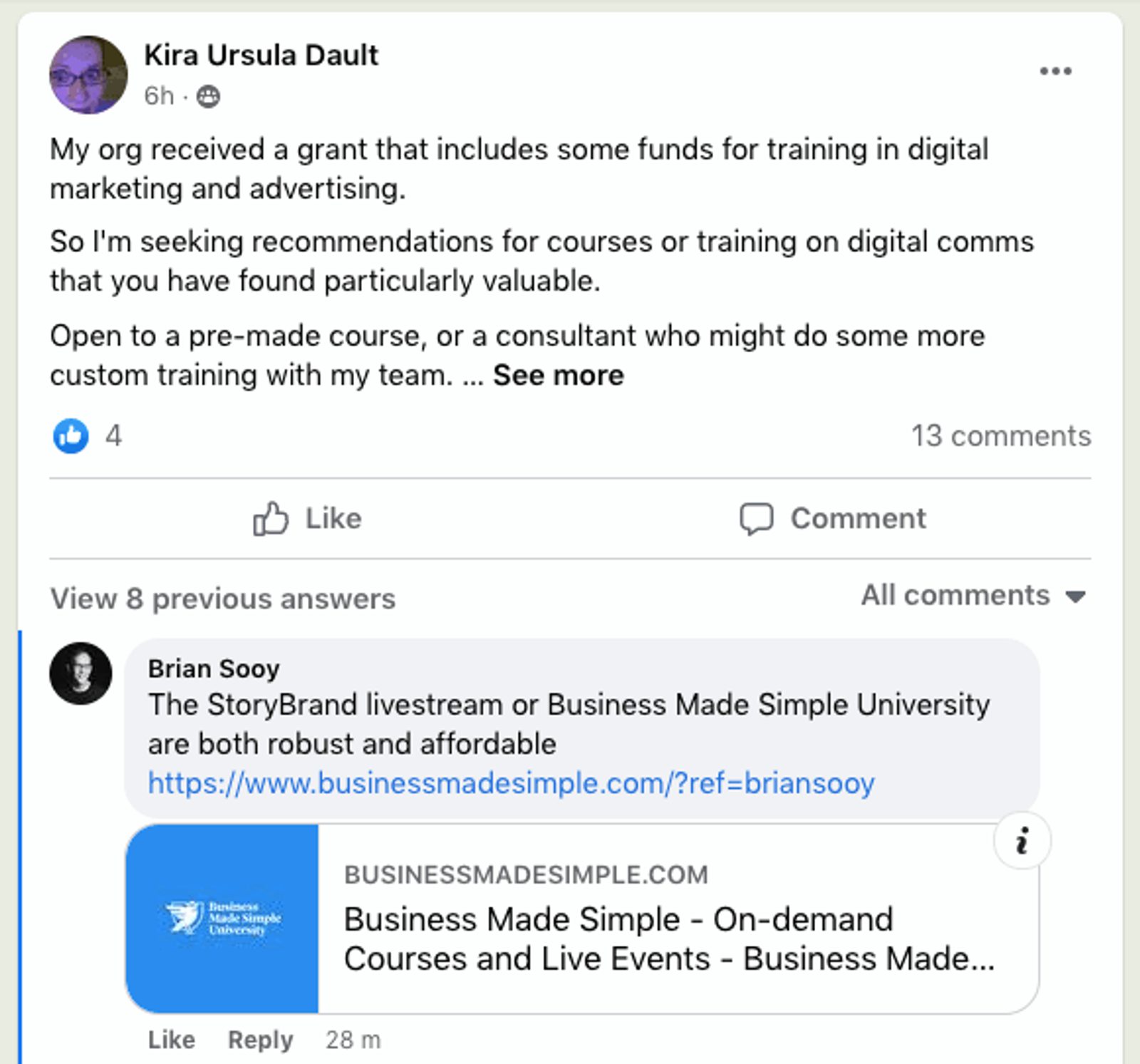
You should also use your network to access different social media followings. If you have a colleague with a huge LinkedIn following, a quick email asking them to share (or even offering pre-written copy) could result in significant traffic.
2. Build relationships by rewarding reader engagement
Strategic social media sharing can help more people make an initial connection with your blog, but you want your blog readership to keep coming back. You can encourage people to keep reading and interacting with your content by acknowledging and rewarding engagement.
One of the most common ways to reward engagement is through social media monitoring, which simply means paying attention to where your brand is being discussed. When someone tags you, it will show up in your notifications (you can also use tools to monitor for untagged brand mentions).
From there, you can like the post, share their take, or respond. A quick tap of the heart icon lets the reader know you appreciate their support. It also subtly encourages them to keep sharing your content.
Your blog’s comment section is also extremely valuable for rewarding and building engagement. If someone takes the time to leave a comment, reward them with a like and a comment back. And if someone asks a question, don’t miss that opportunity to build trust and rapport.

3. Build your email list
No matter how great your content is, it’s unlikely that people will check your blog every day. But people check their email daily (often many, many times every day). That’s why leveraging an email list is a smart way to grow your blog.
A robust list of email subscribers means you can send your content directly to people you already know are interested in you. Check out this post on 15 Proven Ways to Grow Your Email List to find both simple and sophisticated tactics for collecting email addresses.
If nothing else, consider adding a subscription bar to your blog and a sign-up button to your Facebook business page.
4. Network with bloggers and write guest posts
You might think of other bloggers as competition, but collaborating with them is a highly effective way of reaching a wider audience. You will grow your network by nurturing relationships with fellow bloggers in and adjacent to your space.
Plus, you might just land a new platform to increase your brand awareness, which can often lead to guest blogs and other opportunities.
Identify a few blogs you admire whose content and audience cross over with yours (obviously not direct competitors to your business). Next, make an effort to engage with their work and look for opportunities to interact—comment on their blogs, share their content, and suggest them to others. This will introduce you to the blogger and build trust with your audience because you share valuable information.
This engagement can lead to you guest blogging for a more established site. It helps to have an existing relationship, but some blogs even have forms where you can simply pitch a guest blog directly to the editor. To maximize your efforts in guest blogging, many authority websites turn to specialized services, as guest posting might take a lot of effort, if you don't have a dedicated team, and time.
This is where WhenIPost, or similar services, can bring your brand more awareness and save you time. WhenIPost provides full-scale services from a personal list of websites for guest blogging according to your requirements to live blog posts that you will help to reach target goals.

These 4 quick tactics for expanding your blog readership will help you reach new people, but for real, long-term growth, it all comes back to the content itself. Writing blog posts that appeal to readers and search engines alike is the best way to grow your blog.
That’s why we’ll do a deep dive into why you should (and how to) write long blog content and attract more search engine traffic.
Why you should write long blog content (which almost always outperforms short blog content)
If you want to grow your blog, you should write long content that gives in-depth answers to very specific questions that people search for.
(The post you’re currently reading is an example of a long, comprehensive answer to a specific question: “how do I grow my blog?”).
As this section will show, long blog content almost always gets better results than short blog content.
According to Andy Crestodina’s annual survey of 1,000+ bloggers, there’s a positive correlation between longer blog posts and self-reported “strong results.” This is reflected in the fact that the average blog post is getting longer (1,416 words in the 2021 survey) and in the uptick in posts of 2,000 words or more.

A more detailed analysis from BuzzSumo (in partnership with Noah Kagan) shows that content length and social shares are positively correlated.
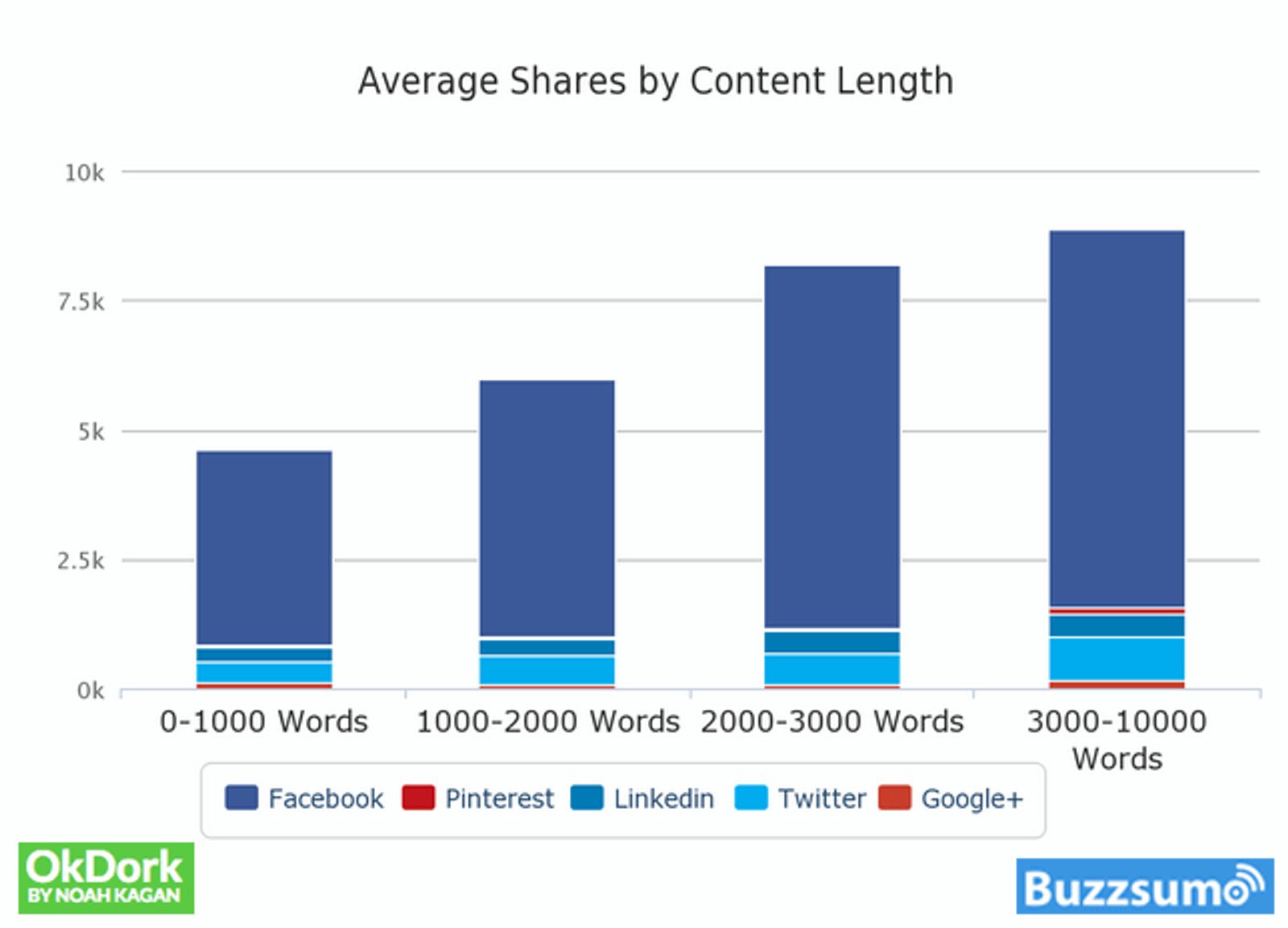
But what about the user? Do people read long content?
Sort of.
Research from Nielsen Norman Group suggests that most people only read about 20% of any web page. Luckily, the length of the content doesn’t seem to affect the percentage much. People seem to read at least some of anything you put in front of them.
But that still doesn’t answer the key question of whether the effort of creating longer content yields better engagement. Fortunately, Medium released research on engagement by length of content. They reported that 7-minute reads (~1800 words) captured the most attention.
Interestingly, as posts get longer, there’s more variation in how long people spend reading them.

In their research, the Medium product science team says: “A larger percent of the longer posts tend to have high values. So while the median time spent decreases, longer posts are also more likely to be 1 of the hits that perform especially well.”
Even though, on average, a 7-minute post was read for the longest, the top-performing posts were much longer. The chart above shows that the post with the most engagement was a ~16-minute read—about 4,000 words!
In short, a long blog post doesn’t guarantee that people will read to the end, but longer posts do hold readers longer and get higher engagement.

That being said, you shouldn’t write content that’s longer than it needs to be. People will abandon content that doesn’t give them what they want. So, instead of asking, “how long should this blog be?” ask, “what does this content need to accomplish?”
In most cases, you don’t need people to read every word of a blog post. They can still get value from your posts without reading them all in 1 sitting.

"The key is formatting. Dense paragraphs make visitors thirsty for a visual break. Subheads, bullet lists and images are like refreshing sips of water for the eyes. They keep scan readers flowing.
So never write a paragraph longer than three lines. And, if possible, add an image at every scroll depth!"
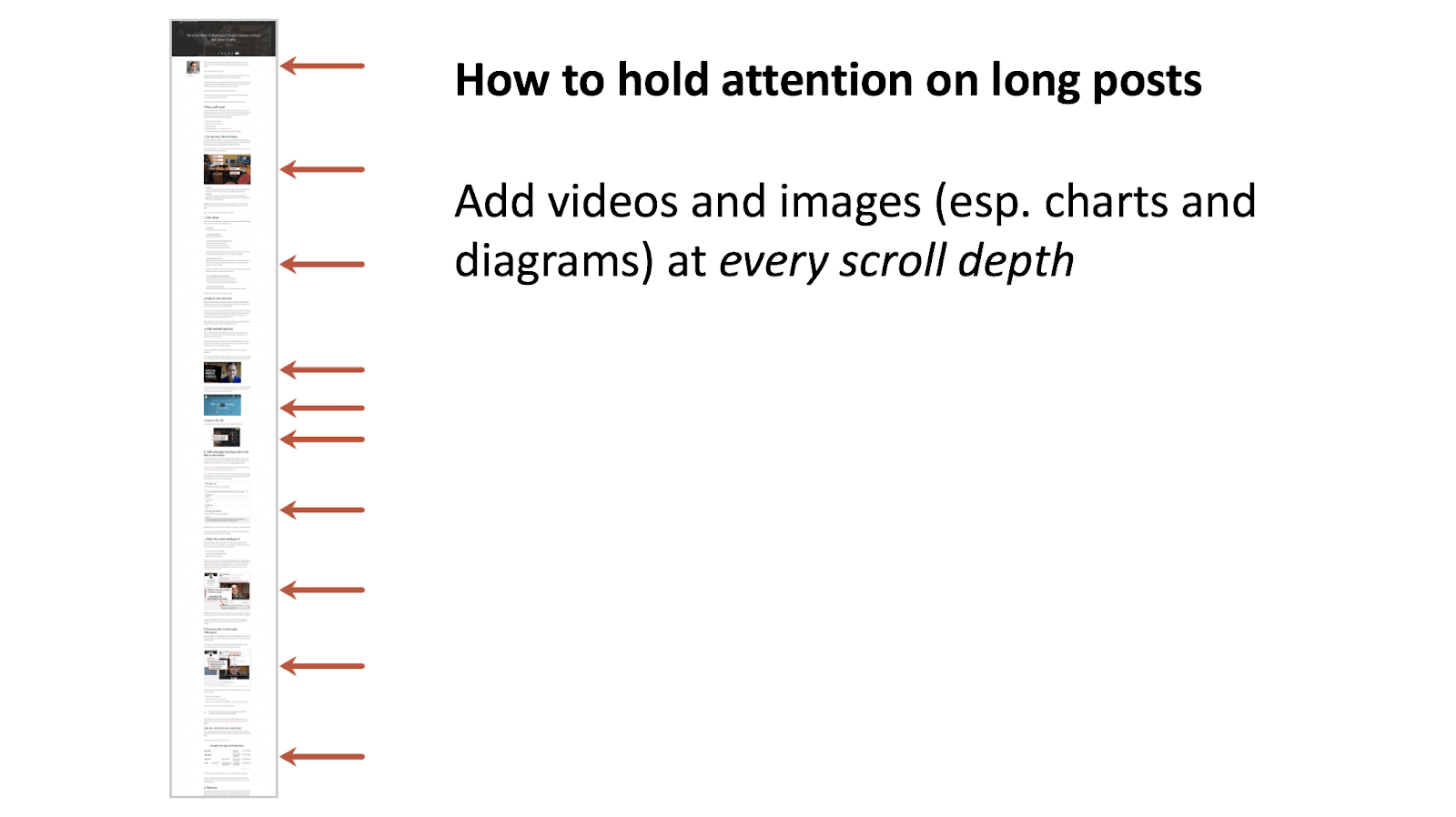
– Andy Crestodina is a content marketing expert and the CMO of Orbit Media
How to write long blog posts that people want to read
Long blog content is more likely to get shared. It’s more likely to rank in Google. It’s more likely to get you more readers.
That is if you do it well.
The Medium research shows that long content can be either the best-performing or the worst-performing content.
If you want your content to work, there are 4 pieces of advice you need to follow:
- Give people exactly the information they need
- Choose a really specific question and answer it fully
- Use the voice of customer language (i.e., use the words your readers use)
- Instead of just giving advice, show people why the advice is right
1. Give people exactly the information they need
College seniors are given 1 of 2 pamphlets about tetanus. The first pamphlet contains graphic images of tetanus patients and skin-crawling descriptions of what happens when you get tetanus. The second has the same core information but is less graphic.
Unsurprisingly, students who got the graphic pamphlet (the “high-fear” condition in the study) said they were more likely to get a tetanus shot.
But only 3% of students (in either group) actually got the shot.
In a follow-up study, Yale researcher Howard Levanthal handed out the same pamphlets—with a slight change. For 1 group of students, he included a bit more information:
- A map of campus with the student health center circled
- A list of times when the tetanus shot would be offered
- A request of the student to plan when they would get the shot and how they would get to the campus health center
Instead of 3%, the number of students who got the shot was 28%.
Even though these students were seniors and probably knew where the campus health center was, the tiny step of showing them exactly how to get a tetanus shot meant that more than 8x the students actually got shots.
You can make your long blog content good by giving your blog readers exact instructions on what to do next.
Our post on what to put in a welcome email series is an example of how we did this at ActiveCampaign.

Giving people the exact information they need also leads them to actually read your posts—and helps you grow a business through content marketing.
Our welcome email series post is a good example. Here’s how it performs:
- 9,365 visitors since being published (mostly from Google), with 1,333 in the last 30 days:
- Ranks #1 for 19 keywords, including “welcome email series” (according to Moz).
- When we offered it as gated content, it contributed 2200 leads in 28 days (a 3.2% conversion rate). As of writing, the conversion rate has increased to 4.5%.
- We created a landing page to offer a downloadable version of this post. When we sent paid traffic to that page, the traffic converted at 15+%.
Because this post has a great, specific, exactly-what-you-need value proposition (“here are 6 emails”), it converts well and is our top-performing lead magnet.
It also gets tons of positive feedback when shared.
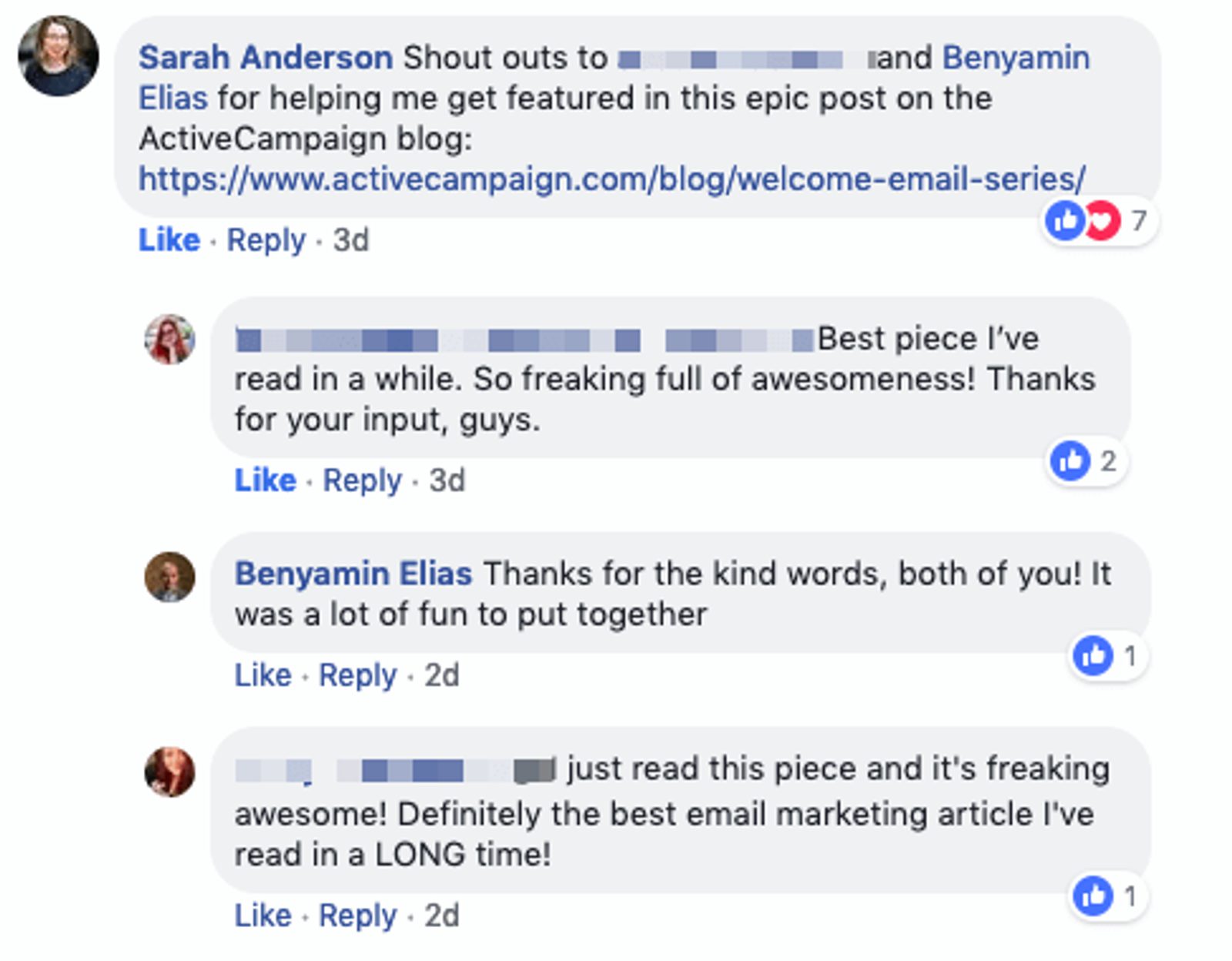
2. Choose a really specific question and answer it fully
What’s the difference between these claims?
- “Sales made simple” vs. “You hate guesswork and busywork—so we made sales less work.”
- “Affordable time tracking payroll software” vs. “The only time tracking tool that pays for itself.”
- “Breakthrough native reporting limitations” vs. “Get the reports your CRM can’t give you—without the headache it does.”
Copywriter Joel Klettke presented these variations at Unbounce’s Call to Action conference.
The first version of each message is vague. The second is more specific—and uses the voice of customer language (more on that in a moment).
You can set your content up for success by getting specific about the questions you answer.
Which is more compelling?
- A Guide to CRM Automation
- CRM vs. Email Marketing vs. Marketing Automation: What’s the Difference?
There’s a place for the first type of content. But the topic “CRM automation” is so huge that you can’t possibly answer it entirely in a single post.
The second topic is much more manageable. By narrowing the scope of what you write about, you can give a better answer to your blog readership!
(You’re also more likely to rank in search engines; more on that in the sections on search).

How do posts like this perform?
This post was first optimized for the key phrase “CRM vs. email marketing,” which is only searched 10 times a month.
The post ranks first for that phrase, but also:
- Brought in 321 visitors in the last 30 days (much more than “should” have been possible based on normal keyword research)
- Ranks for 135 keywords generally related to CRM and email marketing (according to Moz)
- Pulled in the single largest customer from content in the entirety of 2019
Getting specific with your content is another way to give people exactly what they need (method 1). It lets you give in-depth answers to their questions—so that they don’t leave your website to look somewhere else.
3. Write with the voice of the customer
A rehab and addiction therapy center tested 2 headlines: Can you guess which 1 won?
- “Your Addiction Ends Here”
- “If You Think You Need Rehab, You Do”
The second headline absolutely crushed the control—leading to 400% more button clicks and a 20% increase in form submissions (even though the form was on a different page).

Here’s the kicker—Joanna Wiebe, the copywriter on this project, didn’t write this headline. She took it straight out of the mouths of Beachway’s audience. In this case, the phrase appeared in an Amazon review of a book about addiction.
In his book Pre-Suasion, legendary psychologist Robert Cialdini argues that self-relevance (“is this about or for me?”) is 1 of the best ways to hold attention. Using the words your target audience uses makes your blog readers feel understood and makes your content feel relevant to them. And that is what gets them to read all the way through.
You’re also easier to understand. If you’re focused on using audience language, it naturally cuts down on big words and jargon. The best-titled psychology paper of all time—Consequences of Erudite Vernacular Utilized Irrespective of Necessity: Problems with Using Long Words Needlessly—showed that using a bunch of big words actually makes readers think you’re less intelligent.
At ActiveCampaign, we think about how to use the voice of customer language whenever we write anything—including writing about copywriting.

When you do the voice of customer research, you naturally:
- Find more specific questions to answer
- Give people exactly what they need
- Identify relevant keywords for SEO
All of which help boost your content marketing results.
Here are some resources we’ve put together on how to find and use the voice of customer research:

“We have a formula we teach to help our students.

The way I see it, our goal when we go into writing or publishing a post is to make a compelling argument for X, where X is, wherever possible, different from what the world already believes or expects.
So a couple things happening there. The first is the idea of a blog post as an argument, where you're anticipating objections and using third-party resources – like academic studies, split-test results and other articles – to help build your case. Also, we don't want to add to the noise; we only want to publish when we (or our authors) have something to say. That means no listicles of "best practices" but rather a) challenging best practices (like in this post) or b) highlighting something that marketers may have overlooked or forgotten (like in this post).
And finally, arguments can feel... argumentative. That's why we have the writer write in the first person and use his/her own experiences to shape the argument. (So not "how to write an email" but "how I wrote an email.") This covers all manner of sins and keeps the reader off the defensive... mostly. :)
– Joanna Wiebe is the founder of Copyhackers
4. Don’t just give advice. Show why that advice is right
How do you get people to sit up and think, “that’s interesting?”
You can get some answers from sociologist Murray Davis—who wrote a paper appropriately titled “That’s Interesting!”
What, according to Davis, makes an idea interesting?
- An idea is not interesting if it confirms your assumptions
- An idea is interesting if it counters your assumptions
You need your ideas to surprise your audience by challenging something they believe.
But there’s a problem—you can’t just lay out surprising advice and expect people to believe you.
“A man with conviction is a hard man to change. Tell him you disagree and he turns away. Show him facts or figures and he questions your sources. Appeal to logic and he fails to see your point. We have all experienced the futility of trying to change a strong conviction.” -Festinger, Riecken, & Shachter, 1956
People will argue against ideas they disagree with. Research shows that they argue—even if their original beliefs are based on inaccurate info that they know is inaccurate (Anderson, Lepper, & Ross, 1980)!
Worse, arguing against someone’s strong beliefs can cause the “backfire effect,”—which leaves them more convinced of their beliefs than when they started (Nyhan & Reifler, 2010).
Psychologists call this effect “belief perseverance” or “motivated reasoning,” but there are ways around it. Most importantly, people still need some evidence to justify their own beliefs.
“People are more likely to arrive at conclusions that they want to arrive at, but their ability to do so is constrained by their ability to construct seemingly reasonable justifications for these conclusions” -Kunda, 1990 (emphasis mine)
All of this means that you can get people interested in your content by:
- Challenging a medium-held belief in your audience instead of a strong belief. Bonus: Target a self-limiting belief that your audience doesn’t even want to have
- Giving incredibly detailed explanations (like all these psychology studies) to flood people with the evidence that supports your position
Instead of just giving advice, show people why that advice is right. A great example of how we did this at ActiveCampaign is our 6,500+ word guide to writing landing pages.

The landing page guide focuses on the Rule of One principle and lays out the evidence for each of the 4 components of the rule.
Here’s a list of the evidence for the “one offer” portion of the Rule of One (i.e., every landing page should make exactly 1 offer):
- An expert quote from Peep Laja, founder of CXL
- A reference to Hick’s Law (decisions take longer when there are more options)
- A study showing that even doctors make worse decisions if they have more options
- A TED talk (and book reference) by the renowned psychologist Barry Schwartz
- A reference to Steve Krug’s design textbook “Don’t Make Me Think”
- Expert insight from Aaron Orendorff, founder of iconiContent (previously at Shopify)
- Expert insight from Neville Medhora, founder of Kopywriting Kourse (previously at Sumo)
- A case study of an email click-through rate A/B test
Instead of just giving advice, we provided advice backed by 8 separate pieces of evidence—and that was for just 1 of the 4 pieces of the Rule of One!

“If someone were to say to me: "Hey, love your writing. What's the secret?”
My gut response would be: I listen. Namely, I run a lot of automated surveys to my audience – both anonymously, at the point of opting in (onboarding), and later stage.
What I'm trying to learn from this surveying is who someone is and why they're giving me any share of their attention. I see my job as to help as many people as I can using my experience + my ability to research my own audience / third parties. So I take the feedback I got really seriously. Can I help? Are they saying one thing, but actually struggling with something else? To completely satisfy why they're here, what needs to happen?
With that as the foundation, it actually makes writing these monster, 8,000+ word articles pretty simple.
Why? Because my audience has done much of the hard work for me. They've told me what they're struggling with. In their own words, I know who they are and what they need. My job becomes a matter of going through and figuring out how I can collectively respond to what people are telling me (directly and indirectly), and hopefully come up with something that's authoritative, detailed, and – most importantly – makes the reader thing, "You know what...? This was really helpful. I'm going to stick around and share.”
It's hard when you're just staring at a blank page.
And it's almost like cheating when you can engage in a lot of 1-to-1 back and forth with people, mull over a lot of raw, unfiltered survey data, and then curate it all together into something that's legitimately helpful and does more to build trust and create customers than all the fancy-pants sales copy writing in the world.”
– Brennan Dunn is a personalization expert and the founder of RightMessage
Use ActiveCampaign content marketing templates
Managing a blog is difficult, but having a clear process can make it easier. To grow your blog, you’ll need to create more, higher-quality content—and we put together some tools to help you do just that.
These free content marketing templates make it easier for you to focus on creating great work. The templates include:
- Keyword research and outline template
- 23-point editing checklist
- SERP analysis checklist
- Blog scannability checklist
- Four proven outreach email templates
- 11 ways to practice content writing
- Small moments of excellence checklist
These templates show you how to organize your keyword research, how to analyze search results for SEO, how to create blogs that are easier to read, how to promote your blogs—and everything you need to grow your blog faster.

“It's easy enough to create high-quality content with a single writer.
But as soon as you have two full-time writers, hire an experienced editor to oversee every piece that you publish. A great editor will keep your team's content quality and tone consistent, and they'll keep the content pipeline moving; all critical elements of a well-run content operation that can scale.”
– Len Markidan is the CMO at Podia
Why you should focus on getting traffic from search engines
If you Google phrases like “how to grow your blog,” “how to get traffic to your blog,” or “how to promote your blog,” you’re going to come away with a looooooong list of blog promotion tactics to try. That list will include things like:
- Post to Facebook!
- Post to Twitter!
- Post to Instagram!
- Post to subreddits on Reddit!
- (Sensing a theme yet?)
- Add social share buttons!
- Pitch bloggers with cold outreach emails
- Send blogs to your email list
- Add links to your blog subscription confirmation page!
- Add a link to your email signature!
- Repurpose your blog content into every other type of content! (Videos, webinars, SlideShare, infographics, Medium posts, podcasts, ebooks)
- Write guest posts
- Do…something…with influencer marketing
Phew. Is anyone else exhausted?
Lists like this make it seem like every blog promotion tactic is equally important.
But they’re not.
At all.
Most successful blogs get most of their traffic from just a few places. Even if they start using some of these other tactics, they only work because the most important sources of traffic help build a blog audience (that you can promote to).
Instead of checking off an endless to-do list of the latest blog promotion tactics (Snapchat promotion? Is that a thing?), focus on 1 or 2 sources of traffic that make the most sense for you.
And the biggest traffic source of all is Google. When Andy Crestodina asked bloggers what traffic sources were essential to them, search engines were the top choice.
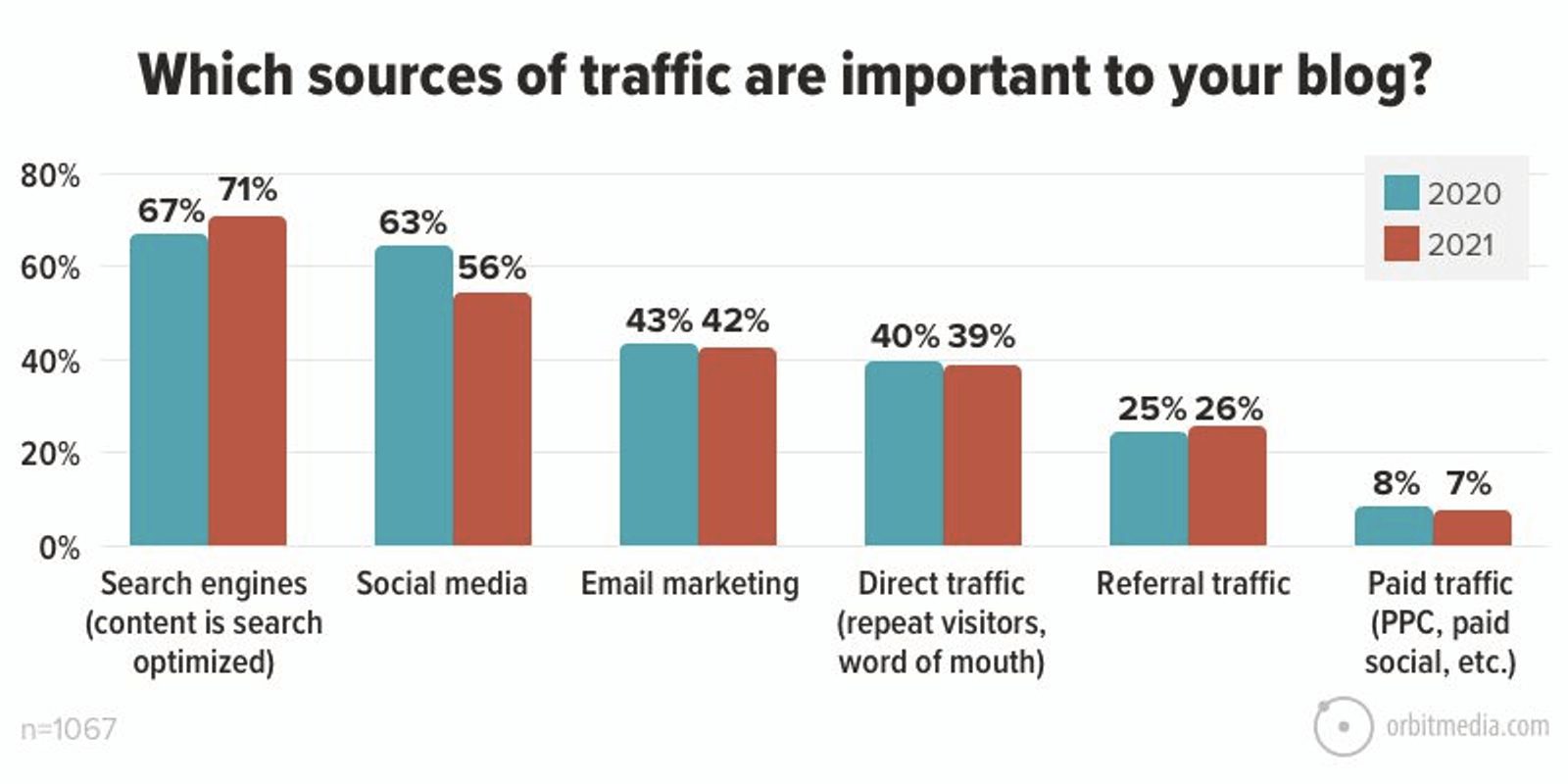
This section will show you that traffic from search engines, especially Google, is the largest and most accessible source of website visitors. If you want to reach a lot of people, organic traffic is the way to do it.
Note that there are a few situations where you might want to take a different, less search-centric approach:
- You’re a consultant or freelancer and only need to convert a small number of people to run your business.
- Your customers are executives who are less likely to turn to Google for answers to their problems.
- You’re in a new industry, and no one is searching for things related to your product yet (although pain-point SEO might still help).
- You really, really need to reach a lot of people (like, multiple millions), in which case a huge PR campaign or TV ad spend are probably the most efficient.
Still, if you need to reach lots of people with content, organic search traffic is the most accessible source.
Because the Google numbers are staggering.
Research from Rand Fishkin (using a Jumpshot data set that I am frankly jealous of) showed that Google refers 57.8% of all traffic in the sample.
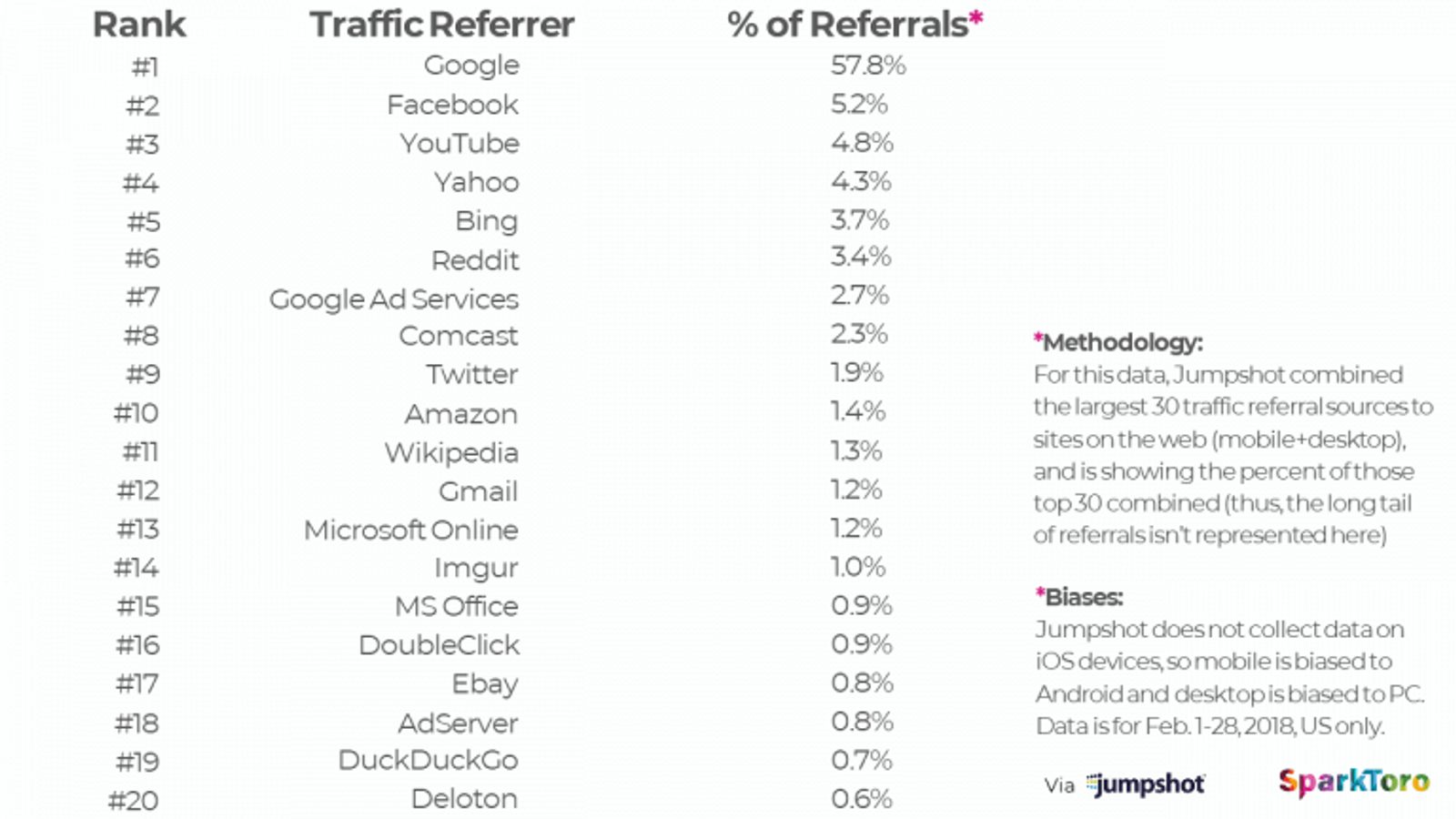
Rand looked at all traffic to all types of pages—not just blog posts.
Are you still questioning if search is the most significant traffic source? People do use social media sites, right?
Hiten Shah’s research on where blogs get their traffic sheds some light on that question. He looked at blogs with different levels of traffic to see which sources of traffic drove the most visitors—and how sources of traffic changed based on the size of the blog.
- At fewer than 150k yearly visits, traffic sources were mixed
- From 150k to 1.5m yearly visits, traffic is mixed, but search traffic begins to pick up
- From 1.5m to 3m yearly visits, search share increases (though there is still a mix)
- From 8m to 15m yearly visits, search is by far the dominant source of traffic
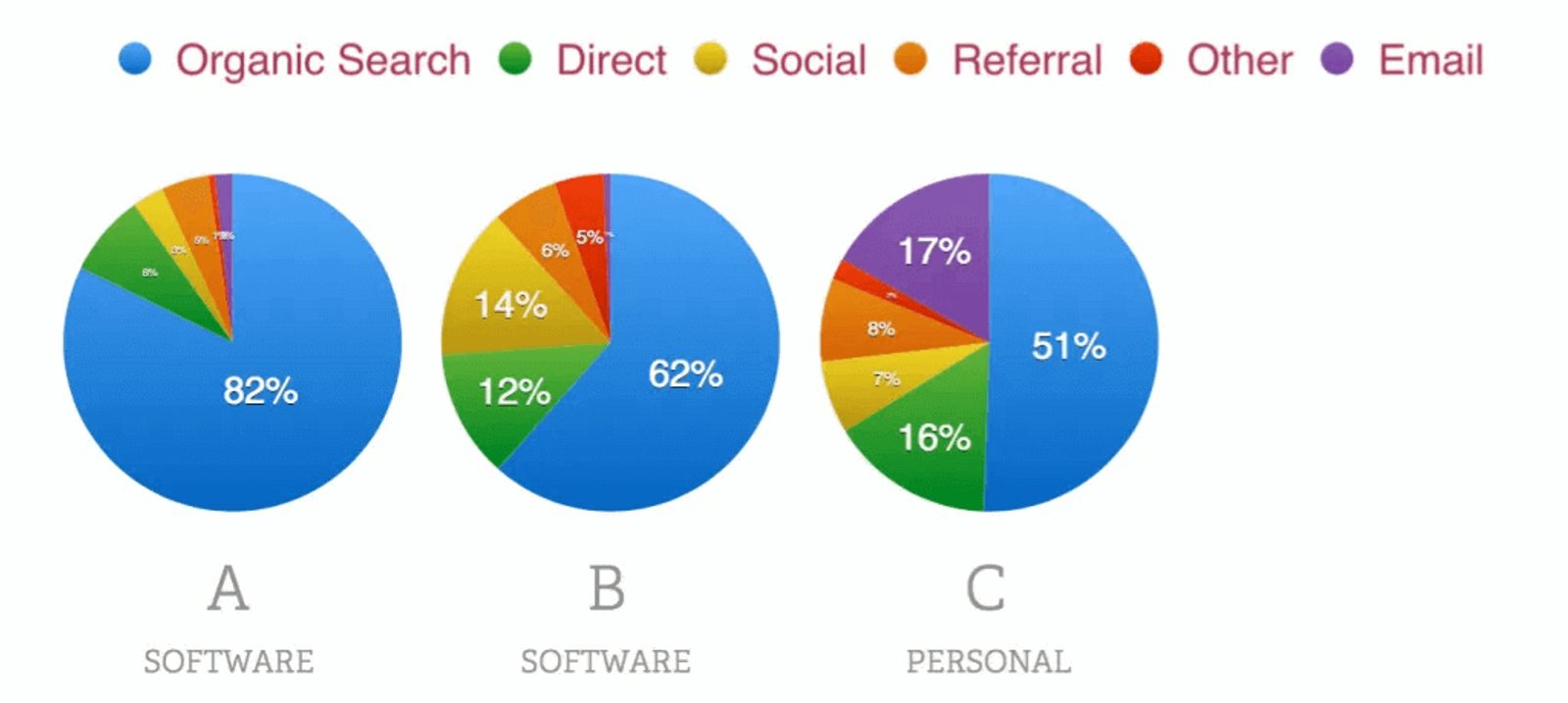
Search makes up more traffic as blog traffic increases—because search is where most of the people are! It’s harder for small sites to show up in search results, but search will become a bigger percentage of your traffic as you grow your blog.
Also important—the sources of traffic that make sense for you might depend on your industry.
In Hiten Shah’s research, he points out that some industries (like software) are more likely to get traffic from organic search than other channels:
“Software blogs that have built huge traffic of 8M+ yearly visitors have done it by winning with organic search. They receive at minimum 3x the traffic from organic search than any other channel of traffic.
In contrast, a big media site like Buzzfeed gets 5x more social traffic than search traffic because Facebook is dominated by news and entertainment content. Personal blog C gets about half of its traffic outside of search.
But software blogs aren’t places that people habitually go to on their own, nor does SaaS content really fit with what people want to read when they’re hanging out on social media sites. Rather, SaaS blogs get large-scale traffic when people look up specific problems on Google and find that the company blog has the answer.”
Jimmy Daly ran SaaS content at Vero and Quickbooks. He argues that organic traffic is critical for blogs that want to grow—for software blogs especially, but also because search success leads to success in other areas:
“The first thing nearly all SaaS blogs should do is aim for 50% organic share. Keep in mind that we measure organic share across the entire site, not just content. It’s likely that content will be the main driver of traffic growth, but that should lift the organic presence of the homepage and product/feature pages. If you aren’t at 50% yet, that’s your next goal.
In order to scale—and we mean really scale, like 250,000 monthly pageviews and beyond—you will need to increase organic share. Search traffic scales in a way that social, email, paid, and referral traffic simply can’t. Large SaaS sites all rely on this same mechanism for growth.”
In a case study of AdEspresso’s traffic growth, Daly elaborates by explaining that organic traffic is a good way to figure out if your blog as a whole is successful:
“The pie charts below show that AdEspresso’s organic presence has been steadily increasing. What it doesn’t show is that traffic from other sources has been increasing as well. This trend is typical of sites with strong organic growth. As search traffic increases—perhaps the most important indicator of a site’s overall health—other sources begin driving more traffic as well. More people follow the brand on social media, subscribe to the newsletter, and go to the site directly. Organic traffic grows faster, hence the pie charts below, but it’s a tide that lifts all ships.”
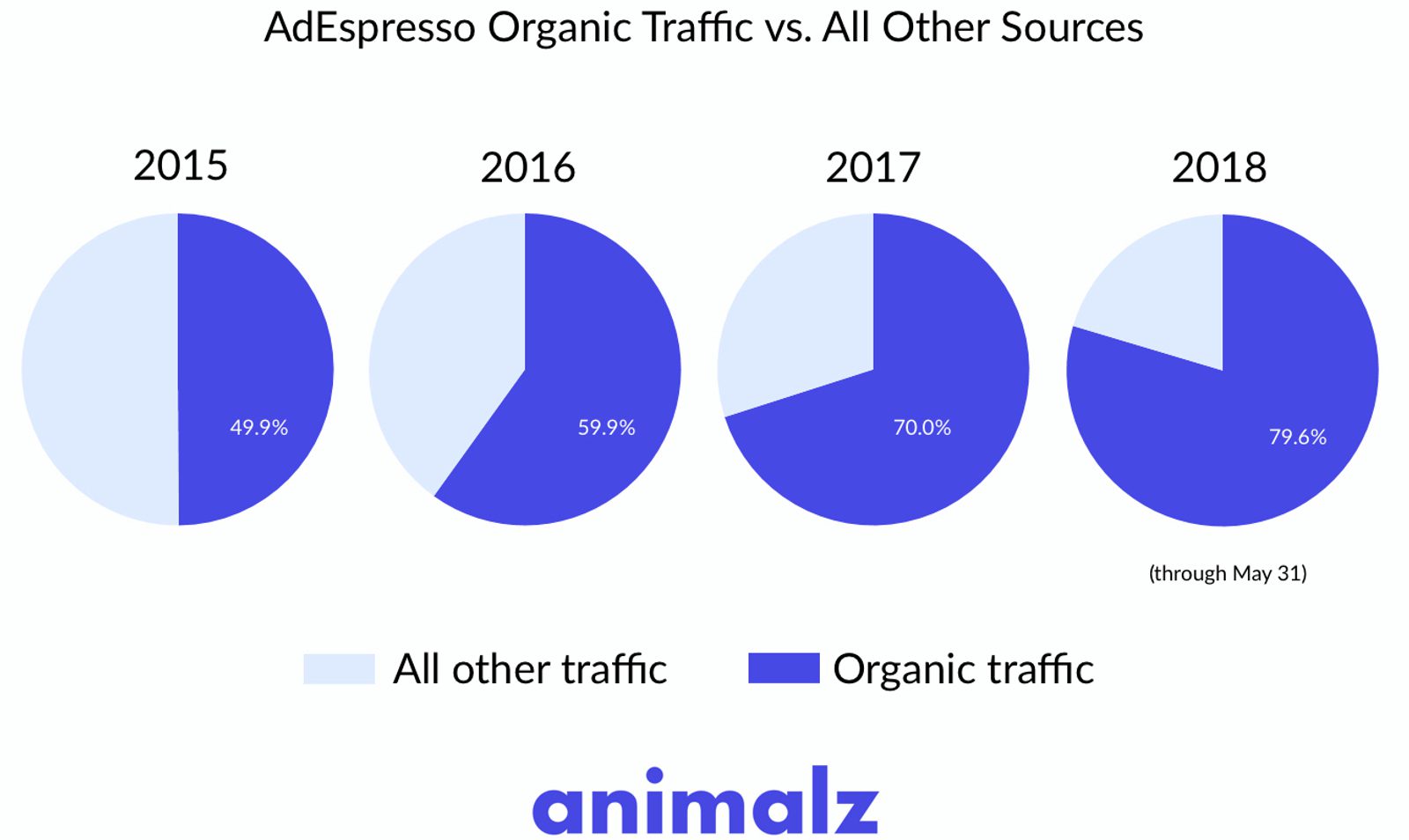
Search is by far the largest source of traffic to blogs. Of course, ranking in search results isn’t always straightforward. How can you get blog traffic from organic search?
How can you optimize your blog posts for search engines?
You can optimize your blog post for search engines by:
- Choosing a great primary keyword
- Finding phrases that show your page is relevant to the overall topic
- Studying search engine results pages (SERPs) to understand what kind of content to create.
Let’s break down how to do each of those things.
SEO is an entire industry, and there’s so much to learn that getting started can feel overwhelming.
Plus, you’ll get a ton of advice about things you “absolutely must do for SEO” (don’t worry, you don’t have to do most of it). That list includes:
- Install a WordPress SEO plugin, like Yoast
- Optimize your meta title and meta descriptions
- Make sure your posts are mobile-friendly
- Use page speed insights to make your page load time faster
- Do link building to build up your domain authority
- Create internal links between your blog posts to improve crawlability
- Make sure all of your images have alt text and optimized image file names
- Use short URLs for all your posts
- Include keywords in your H1s, H2s, and H3s, and your title tag
- Submit a sitemap to Google and use Google Search Console to check your crawlability
These aren’t necessarily bad advice—but they give you too much to think about. And most of the results you can get from search engines come from doing 1-3 things really well.
You can follow these simple onsite SEO best practices from the list above (to get most of the way there):
- Make your URLs short, and include a keyword (WordPress, Squarespace, and other website builders make it easy to change URLs)
- Once you have your primary keyword, put it in your headline and throughout your post
- Make sure your posts are crawlable by Google (i.e., Google can see them). An SEO plugin like Yoast can manage this for you so that you don’t need a developer.
Outside of those, there are 3 things you can do to give your blog posts the best chance of getting traffic from Google. Best of all, you can do them even if you aren’t an SEO expert.
Here are the 3 most important blog SEO practices:
- Choose a primary keyword based on “pain-point SEO”
- Find related phrases that show Google what your post is about
- Study what already shows up in Google so that you know what to write
1. Choose a primary keyword based on “pain-point SEO”

“Take top questions that you get from prospects or top pain points that you hear on sales calls and run searches in Google to see what suggested searches come up around a topic. The reason being: if Google suggests a search or top question, you know multiple people are searching for an answer to that question. Then write a blog post answering that question or walking people through how to solve that pain point.
Prioritize the questions and or pain points that have the highest buying intent for your product or service. To figure that out, ask: What are the questions that people ask prior to buying? They're usually looking for reviews or comparisons between you and other competitors in the market.”
– Benji Hyam is the founder of Grow and Convert. You can read more about his approach to pain-point SEO here.
What problems can you solve for your customers? What do you hear them complaining about the most?
People search for answers to those problems. All you need to do is figure out how they phrase those searches. With pain-point SEO, you can rank for those phrases even if you have a small website—because most other writers don’t put in the work to find real audience problems.
You’ll notice that we didn’t optimize this post for the word “blogging.” Instead, we focused on a more specific key phrase: “how to grow your blog.”
Here’s how to find the primary keywords for your blog posts—the phrases to include in your URL, headline, and throughout your content:
- Find the problems that your customers complain about most often
- Start listing out some possible phrases that someone might search to solve those problems
- Run those phrases through a keyword research tool to see if people search for them
- Repeat until you find a phrase you like
The first 2 steps are mostly brainstorming—no fancy SEO tools required. You can find the problems your customers complain about while finding the voice of customer language (from the sections above). This post shares some ideas on how to do that. Here’s a short list:
- Talk to your customers on the phone.
- Talk to a sales team (if you have one).
- Look through emails that your customers send you, and pull out common phrases.
- Look at reviews for your product, similar products, or books (on Amazon) that solve similar problems.
- Mine online forums (and sites like Quora and Reddit) to find common questions.
- Use a tool like Answer the Public to see what questions people ask.
Expert Insight: Adrienne Barnes on how to know your audience

“The best way to create a content strategy that leads to better engagement and sales is by knowing the audience well. My first step is to get on the phone with about 10 customers. I ask questions that help me understand their feelings about my client’s product/company – their joy, frustration, annoyance, pleasure around the product.
I'm looking to learn where they go to for information, but I also want to know why they find a feature amazing, and what is it about a tool that frustrates them. When interviews are complete, I analyze all the responses and create a spreadsheet of what I call "relational keywords." It's an entire spreadsheet filled with the customer's language in relation to my clients product/company. When I combine those words with SEO keyword research, the editorial calendar and blog topics fall into place!
I'd say the most beneficial thing for someone identifying their audience for the first time is to start by knowing your customers well. Then build out the strategy based on customer's needs, concerns, knowledge gaps, and frustrations.”
– Adriennne Barnes is a content marketing consultant. She uses her relational analysis framework to help companies get as close to their customers as possible.
Once you have a list of pain points and some phrases to try, run them through a keyword research tool. Common keyword research tools include:
- Moz
- Ahrefs
- SEMrush
- Google Keyword Planner
- Keywordtool.io
- Ubersuggest
At ActiveCampaign, we primarily use SEMrush for our content keyword research. If you want to grow your blog fast, a paid keyword tool like Moz, Ahrefs, or SEMrush is your best bet.
But if you’re just getting started or otherwise don’t want to spend money on a tool, Ubersuggest is a free resource you can start with.
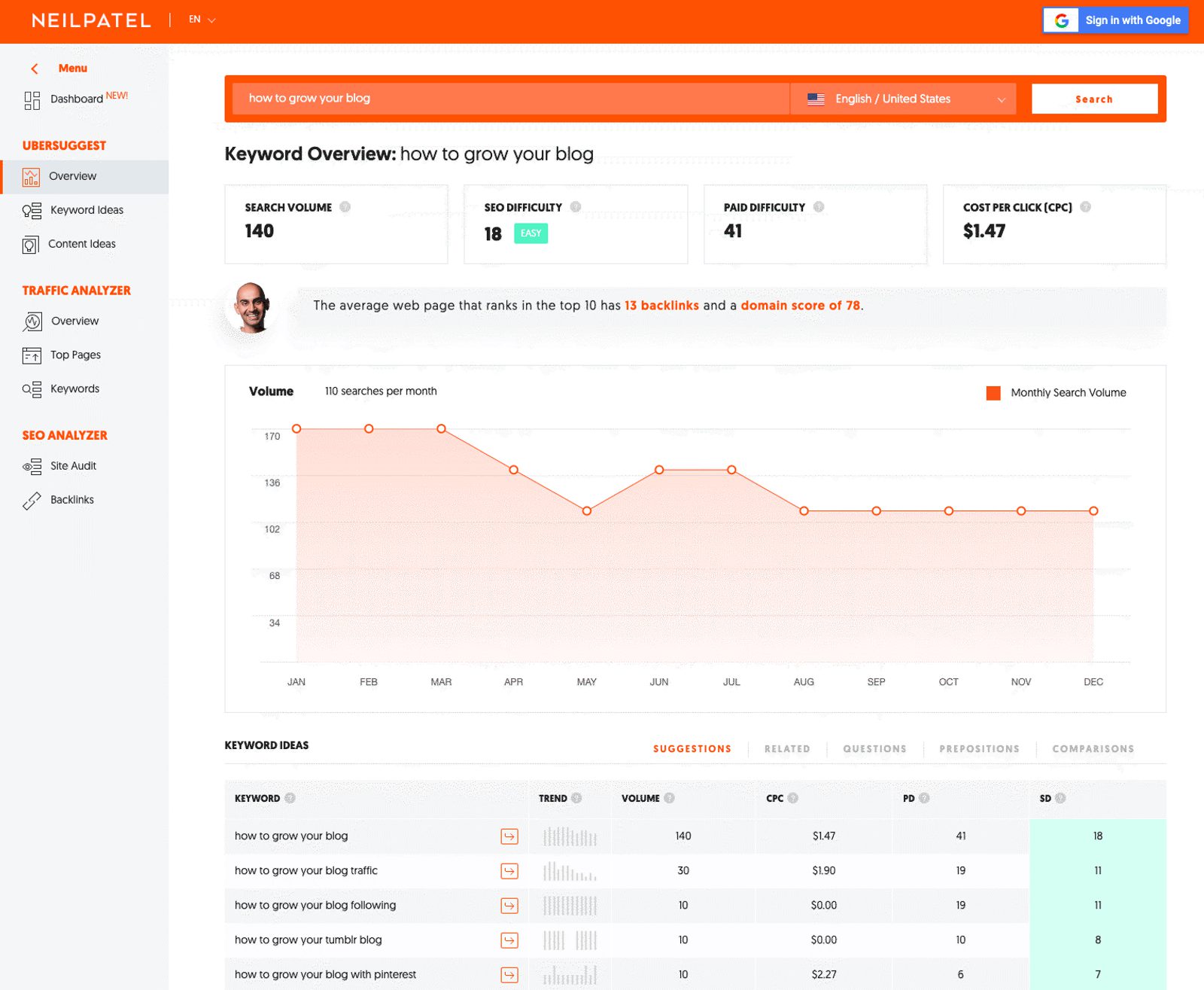
Put each pain point phrase you’ve collected into your keyword research tool. Are people searching those phrases? Is the difficulty score low? Do any of the suggested keywords look promising?
(Note: You don’t need a lot of people to be searching these phrases. Even 10 searches a month can be enough, for reasons covered in the next section).
If you invest in a paid SEO tool, you can add another step: When you check each of your phrases, you can put in the URL for the top-ranking page—to see what other phrases that page ranks for.
Here’s what that looks like in Moz.
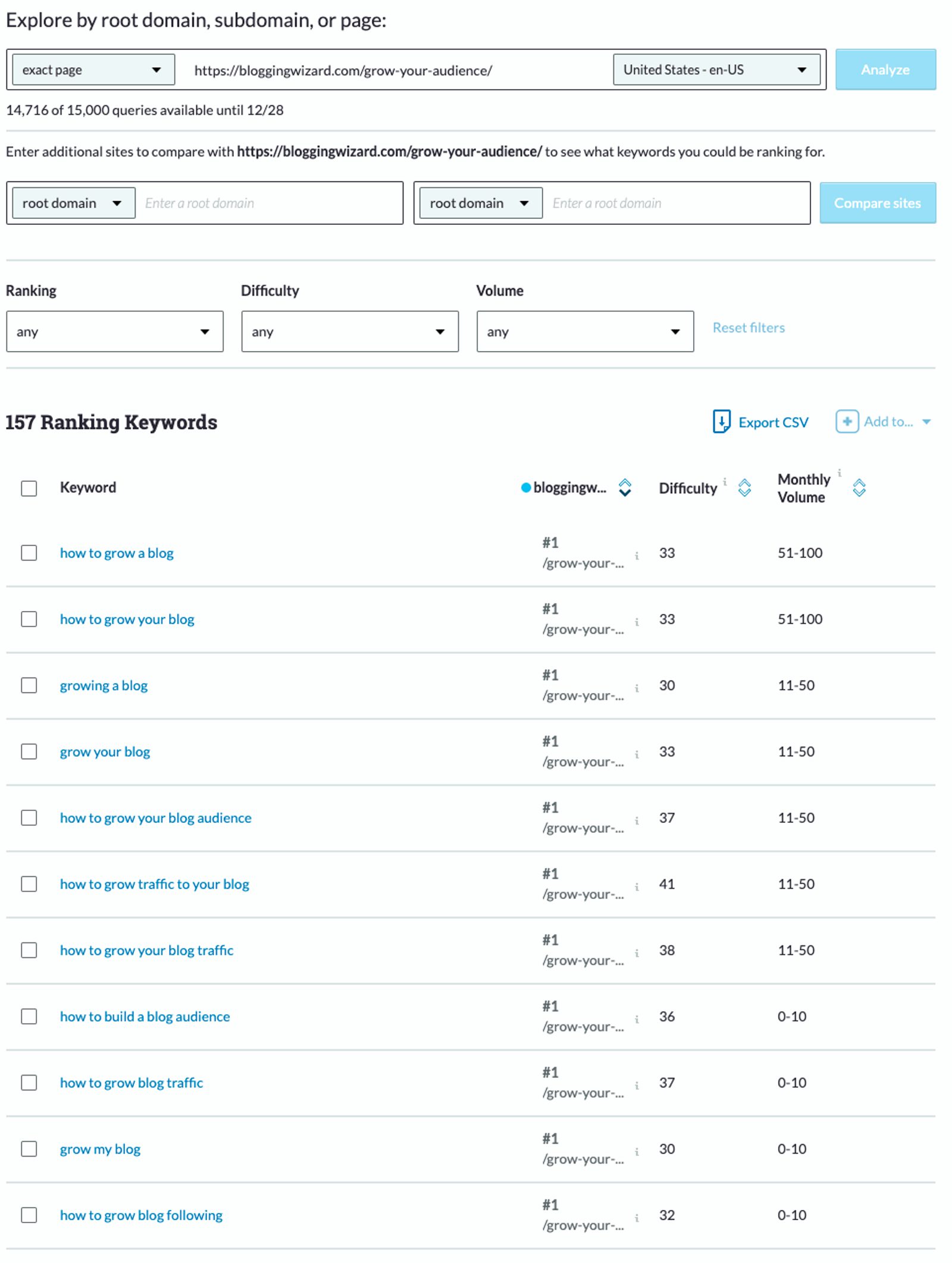
If you try this, you’ll usually find that the first few keywords are closely related to the main keyword (“how to grow your blog”).
But if you scroll down, you’ll find related phrases that could be good primary keywords—o
r new blog post ideas!
In this example, I found phrases like “how to attract more readers to your blog,” “how can you make your blog popular,” and “find readers for your blog”—all of which are different ways to ask the question, “how do I grow my blog.”
Go through this process until you find a keyword that makes sense for the blog post you want to write. Now you have your primary keyword!
2. Find related phrases that show Google what your post is about
How does Google figure out what your blog posts are about?
The short answer is Google looks for phrases related to the main topic. However, the next section has a much nerdier and more detailed breakdown of the answer.
For example, if you wanted to write about a topic like “what are the different types of CRM,” you would include related keywords. A quick search in Moz gave me a list that includes phrases like:
- Types of CRM
- Strategic CRM
- CRM examples
- Operational and analytical CRM
- Types of pipelines
- CRM benefits for sales reps
- CRM categories
- Types of relationship management
All of those phrases are definitely related to the topic “types of CRM,” so it’s worth including them in your post.
But what would a CRM expert write about this topic?
Sales teams usually use CRMs, so a CRM expert would probably mention things like sales pipelines, contact management, cold outreach emails, and phone prospecting.
Google wants to show results that are most relevant to the overall topic—and a “types of CRM” page that includes those other (expert) phrases are more likely to seem relevant to Google.
Google’s Search Quality Evaluator Guidelines talk about E-A-T (Expertise, Authority, Trustworthiness).

Fundamentally, the logic looks like this:
- An expert is more likely to use all of these related but hard-to-find phrases
- Therefore, Google uses those phrases to guess the level of expertise of a blog post
- If you include those phrases, Google is more likely to think your blog is relevant to the topic
How can you find those hard-to-find phrases?
By looking at the posts that are already ranking! That’s what ActiveCampaign did when we wrote our very own post about “types of CRM.”

With this post, we couldn’t quite take the top spot in Google (although our post still brings in about ~130 readers per week). That’s actually what makes it a great example—the top spot on this search engine results page is intensely optimized.
Take a look at some of the phrases that appear in the top-ranking post. See if you can spot the examples in the last paragraph.

The information in this post isn’t great. If Google gets smarter about measuring content quality, this post might suffer (and for our post, we chose to give more in-depth higher-quality information).
But right now, the related phrases in this post show Google that this is relevant content—so it’s at the top of the search results.
How can you do this?
- When you optimize blog posts, scroll through the top-ranking posts for your keyword.
- As you read, put together a list of phrases that keep showing up.
- When you write, include those phrases.
If you do this well and keep your content quality high, Google will see that your page is relevant. And because you’re speaking Google’s language, it should also future-proof your SEO.
Expert Insight: Nadya Khoja on how to optimize blog posts

“Before you can drive traffic from search, you need to set your content up for success.
All successful content relies on a content strategy framework I refer to as GRAP: Goals, Research, Authority, and Promotion.
1. What does this content need to achieve? If you have a high domain authority (DA) you can aim to create content that converts users, but if you’re still building your DA, you want to focus on building your authority. Creating content around statistics, roundups, and infographics for your own site and other high-quality sites is a great way to scale your DA quickly.
2. Research your metrics. What keywords do you want to rank for, and who is ranking for them at the moment? What do they offer, how many backlinks do they have?
3. You need to create quality content that is optimized. With more changes in the search algorithm, keyword stuffing isn’t going to cut it. Your content has to provide genuine value for readers AND be properly optimized. Fast load speeds, helpful links, and answering questions and problems that readers have in a clear, actionable way. Without this quality content, your authority on the subject (and Google) drops off a cliff.
4. And finally, promotion is king. Before you can drive traffic from search, you need to drive traffic from your network. Build backlinks, share on social media, link from existing articles. If nobody knows your content exists, Google won’t either. The more eyeballs you can get on your piece, the quicker you can build your traffic flow. In a world where everybody is building backlinks you need to think creatively. Offer to write a guest post or create other forms of valuable content for their sites. One thing Venngage does a lot of is creating custom visuals like timelines, presentations and more for other influencer to develop valuable and long-term partnerships.”
– Nadya Khoja is the Chief Growth Officer at Venngage
3. Study what already shows up in Google, so that you know what to write
Even if a keyword seems relevant to the topic of your post, it might not be.
Why?
Before you write a word of your blog post, you should Google your keyword to see what else shows up.
Initially, the keyword for this post was “how to increase blog traffic.” But when I Googled that phrase, most of the content wasn’t what I wanted to write about.

I wanted this post to be about how to get more people to read your blog, but I didn’t want it to become a list of content marketing tactics to try—because I think you only need 1-3 methods that work (instead of an overwhelming to-do list).
When you Google your keywords, you’ll probably come across some similar themes:
- A lot of “what is [keyword]” posts
- Listicles with high numbers (e.g., “67 ways to do [keyword]”)
- Listicles with low numbers (e.g., “6 ways to do [keyword]”)
- Case studies or examples
- Ultimate guides
- “How to” posts
There are other types of SERPs, but those are the most common.
Looking at what currently ranks helps you understand the “searcher intent”—the type of content people are looking for when they search your keyword. Unfortunately, you won't get much traffic if you write a “how-to” post for a keyword with mostly listicles.
An example from ActiveCampaign—we refreshed the content on our blog post about “abandoned cart emails” so that the post was closer to what people were searching for (examples of abandoned cart emails).
The post had been live for a little over a year and was getting 22 visitors per week. After the update, traffic climbed until it hit 1,000 visitors per week.

Once you know your primary keyword, Google it to make sure that the blog post you want to write is a good fit for the SERP. If not, consider changing your content or looking for another keyword.
Expert Insight: Aaron Orendorff on differentiation in SEO

"Two strategies must overlap and interlock. First, after traditional keyword research to determine organic demand (i.e., high-volume for top-of-the-funnel content; high-CPC for bottom-of-the-funnel) you have to then layer on, second, the core ideas that differentiate your organization’s approach from your competitors. In practice, this one-two combo can work in either direction.
For example, in a recent piece I co-created with Common Thread Collective, we started with its “ecommerce growth equation”: V (visitors) x CR (conversion rate) x LTV (lifetime value) = Revenue. But — as insanely valuable as that is to shape its audience’s own approach — nobody is searching for ecommerce growth equation.
Instead, by researching organic demand, we reframed around the headline “Ecommerce Business Strategy: The Growth Equation, 3 Metrics & 5 Tactics to 3x Your Revenue in 2020.” That way the audience gets what they need (even if they don’t know they need it) and the brand gets to prioritize what matters to them."
– Aaron Orendorff is the founder of iconiContent
Do The Most With Your Blog Growth
Why does this approach to SEO work? Warning, nerd alert: optional nerd info ahead.
You can get organic traffic to your blog post by:
- Choosing primary keywords based on your audience’s pain points
- Finding hard-to-find phrases that help Google understand what your blog post is about
- Glancing at search engine results to make sure your content matches searcher intent
Why does this work?
This section—which is optional—covers the reasoning behind this approach to blog SEO.
Specifically, we’ll cover:
- Why most searches are unique (and what that means for your content)
- How Google understands what pages are about
1. Why most searches are unique (and what that means for your content)
Way back in 2009, Moz reported that most searches were for long-tail keywords. That is, even though individual phrases don’t get searched that often, people search for so many phrases that long-tail keywords still account for about 70% of all monthly searches.
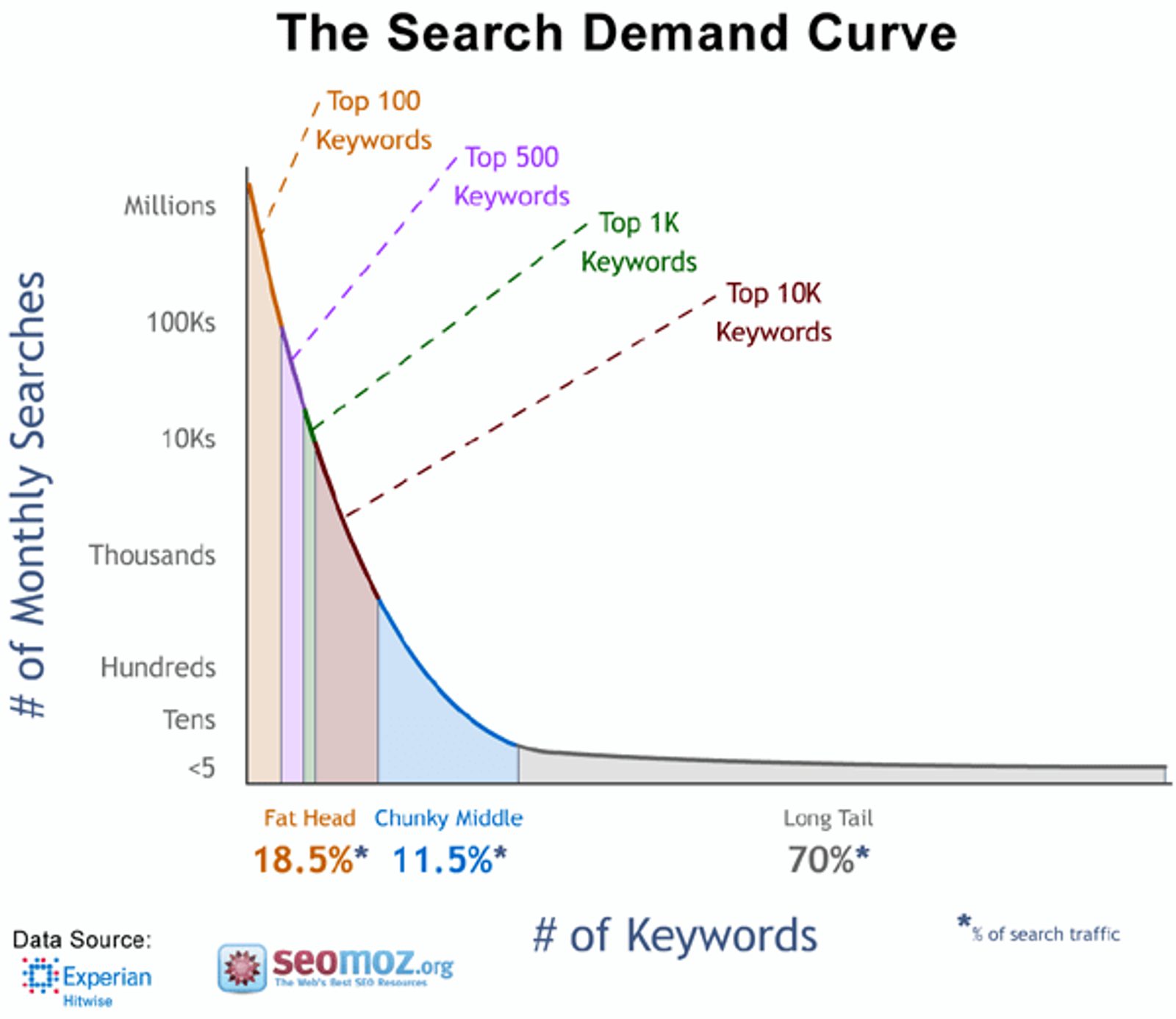
Head terms (shorter, very popular keywords) vs. long-tail keywords is the difference between someone searching “landing page” or “how to build a landing page” and someone searching “how do I attribute revenue to people who convert on my landing page?”
If this research is from 2009, doesn’t that make it incredibly outdated? The last decade has seen significant changes to Google—but this research is still relevant because it’s about what people search for instead of how Google works.
Most searches are unique, or close to unique—meaning that the exact sequence of words that someone enters into Google doesn’t get searched very often.
Because searches are unique, there probably isn’t a specific page that exactly answers every inquiry—but Google still needs to show people something.
What does Google do when someone searches for a phrase that doesn’t have a clear answer anywhere on the internet?

Google won’t give you a blank search result unless it absolutely has to. When someone searches a query that doesn’t have a clear answer, Google gives its best guess.
Warning: Google patents ahead.
At ActiveCampaign, we dug deep into Google patents to understand what Google shows for these long-tail keywords.
You don’t need to read the Google patents listed here—but here are some of the big ideas we learned from reading them.
- The Google patent “Obtaining authoritative search results” (summary of the patent here) implies that if Google can’t find a good post to show for a search, it will pull the most popular posts from similar searches.
- A second patent, “query augmentation” (summary of the patent here), suggests that Google uses the performance of content in search for 1 query as a signal for similar queries. If a post ranks well for 1 search term, it will probably also rank well for other search terms.
In short, 1 piece of content tends to appear in search results for multiple queries.
If this is true, you should see posts that target low-volume phrases pull in much more actual search traffic than you’d guess from the keyword research.

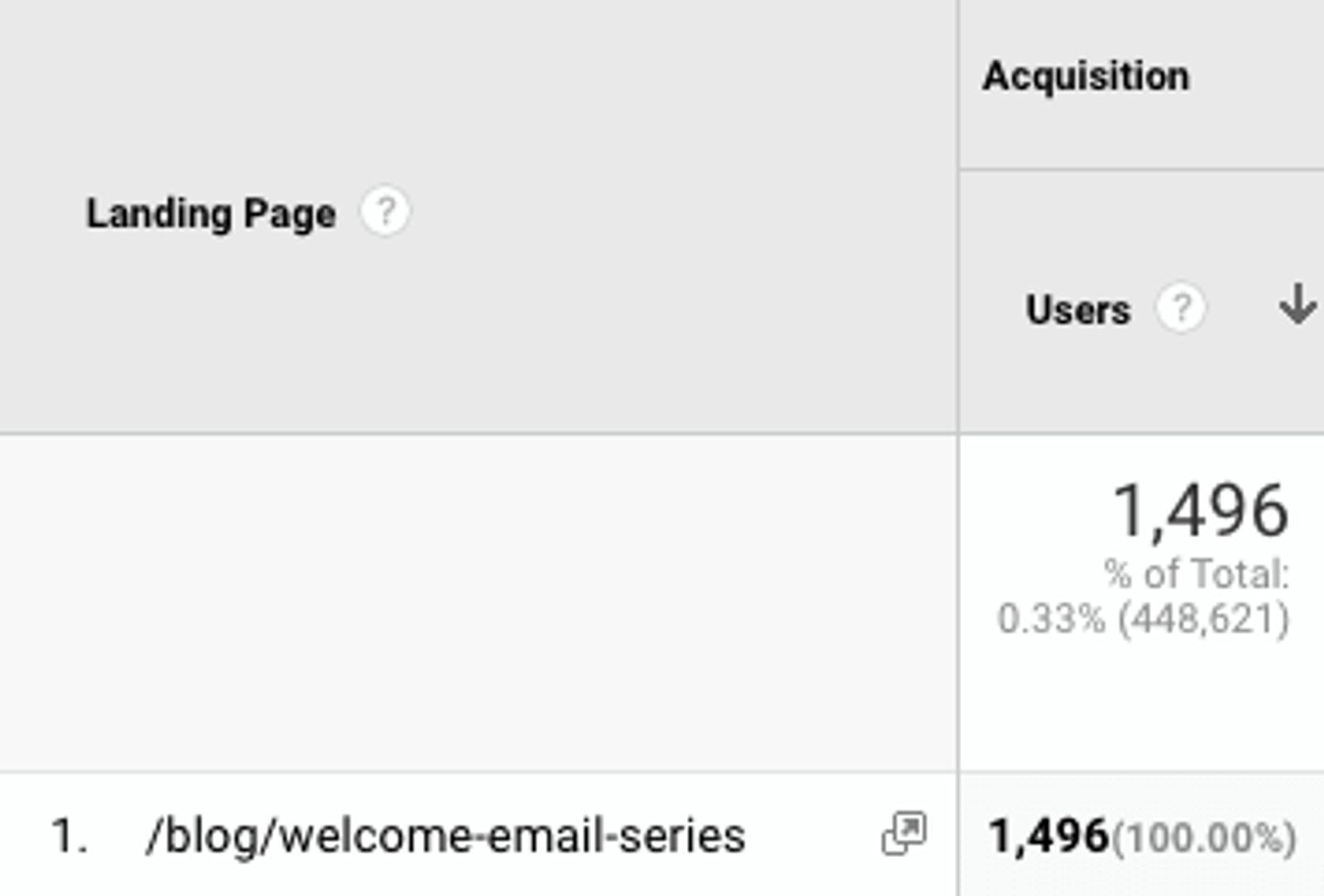
Although most content marketers don’t target this type of keyword, there are a few people on the cutting edge of this.
- Benji Hyam of Grow and Convert refers to this approach as “pain-point SEO.”
- Wil Reynolds of Seer Interactive tells clients, “I’m going to target keywords that have zero search volume” (he shared this insight at Content Jam 2019).
- Ryan Law of Animalz argues that “low-volume keywords have high volume in aggregate.”
Even though a phrase like “how do I attribute revenue to people who convert on my landing page” doesn’t get searched very often, a LOT of people are trying to solve the problem—figuring out how much money they make from landing pages.
If you write a blog post that answers that question—and optimize it so that Google understands—you should be able to snag up more search traffic than you expect.
2. How Google understands what pages are about
When someone puts a search query into Google, Google looks for pages on the Internet that include that query. Then it looks for other phrases that often show up on those pages.
After that, it takes those new phrases and does the same thing—look for pages that include the related phrase, then sees what other phrases show up.
And again, and again, and again.
Generally speaking, this is the approach that Google takes to understanding content: “What pages does this phrase appear on, and what else usually appears on those pages? If a page has a lot of those things on it, it’s probably related to the phrase.”
A search algorithm like Google uses natural language processing (NLP) to understand the overall topic of a page. NLP is a branch of linguistics and machine learning that lets computers make connections between different words.
Expert Insight: Britney Muller on natural language processing

“Having a basic understanding of NLP will help you to strategically craft your content to rank better in search results. From better organizing your videos, so Google can show a specific section of your video (for a specific video-intent query) to crafting better summaries to win featured snippets, foundational NLP awareness can help you think more like Google.”
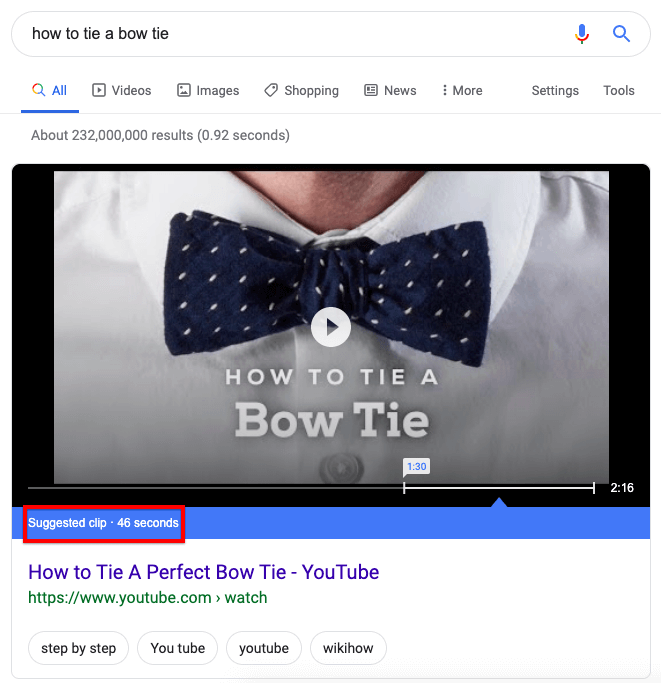
– Britney Muller is the Senior SEO Scientist at Moz
The mechanics of exactly how Google understands pages are complicated, and it probably takes engineering experience to really dig into. The content marketing team at ActiveCampaign isn’t full of machine learning experts, but we did look at these patents to inform our SEO strategy:
- Patent: Predicting site quality. Written summary here. The patent discusses using n-grams to break down a web page and create a language model, “wherein the phrase model defines a mapping from phrase specific relative frequency measures to phrase specific baseline site quality scores.”
- Patent: User-context-based search engine. Written summary here. Google, given a query, looks at all pages for that query. Then it looks at other phrases that often coincide with the original phrase, then looks at those phrases…and so on, recursively, to create a context vector that quantifies the relationship between words.
- Patent: Phrase-based searching in an information retrieval system. Written summary here. As with the previous patent, this patent appears to focus on understanding how phrases relate. From the abstract: “Phrases are identified that predict the presence of other phrases in documents.”
- Patent: Re-ranking Resources Based On Categorical Quality. Written summary here. Google likely can identify the category of interest from some search queries. Rankings can change based on category, with resources known to have high quality for a particular category prioritized. Note that this presupposes the ability to identify intent (and the patent holder has a background in intent research).

If this looks like gibberish, don’t worry! The linked summaries are a great resource—but the rest of this post explained how to give Google the info it needs (so you don’t need to read the patents unless you really want to).
Conclusion: How to grow your blog traffic
When you build a blog readership, the value isn’t the blog—it’s the readership.
This post showed you how to grow your blog. You can grow your blog by:
- Writing long-form, detailed answers to really specific questions
- Optimizing your blog posts for search engines, the largest source of traffic
If you run your own business or have your own blog, that’s great! You’re all set.
If you’re a content marketer or you run a company blog, you may still need to convince the rest of your company of the value of content marketing.
Expert Insight: Robert Rose on the communicating value of content

“The most important thing for content marketers to understand is that what we are communicating is not the value of the content, it is the value of the relationship with an audience. Our content has zero value unless it changes a behavior in our audience.
So, when we communicate value – we must start with three questions: why/what/how our content will change behavior that will benefit us? How do you find that? Look for the gaps? What do audiences do that unengaged audiences don’t?”
– Robert Rose is the co-founder of the Content Marketing Institute, where he manages the content consulting group The Content Advisory
Robert Rose explains that to communicate the value of content marketing, help people understand how valuable it is to have an audience you can access whenever you want.
Sean Blanda strongly advocates creating a publication for your business—a concrete, branded content marketing program that you can use to build your blog audience.
Expert Insight: Sean Blanda on publications vs. collections of blog posts

“A publication is a brand, and a brand should have a clear mission, voice, and purpose. A good test: if you were to cover up the logos on your site, would a reader know it was you? If yes, that's a publication.
A publication is also a business and a business provides value. If your publication were to disappear tomorrow, would people miss it? If you're a publication, you're improving the lives of your readers and they'll certainly notice if you're not around.”
– Sean Blanda is the director of content at Crossbeam and founder of Pilcrow House
At ActiveCampaign, we grew our blog from 8,765 monthly visitors to 119,037 visitors by building long-form content optimized for search engines. And in this post, we broke down how you can use the same tactics to grow your blog. Whatever your industry, creating valuable content that answers customer questions is the best place to start.



